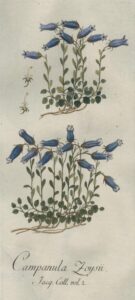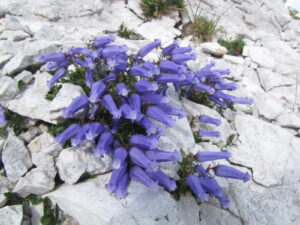Zois’ Bellflower (Campanula zoysii) is tiny and delicate, that grows from bare rock. Its blue blossoms are most unusual. The mouth of the corolla is not open as is usual in other bellflowers but is narrowed. It grows only in the southwestern limestone Alps and is a true daughter of the Slovene Alps as described by the botanist Viktor Petkovšek. The botanist Karel Zois (1756-1799) found the bellflower in the Bohinj Alps and on Mt Storžič. He sent it to the Klagenfurt (Austria) botanist F. X. Wulfen who named the flower after its original finder: We owe our first knowledge of this very rare plant to the well-known noble, Mr. Karl Zois, who has dedicated himself to Botany, offers it his undivided attention, effort, time, and undoubtedly not a little money. Zois’ bellflower’s outer morphological structure alerts us to the fact that this is a very ancient plant, a relict of the Terciary Period, one of the most beautiful and most characteristic of the Slovene endemites. The flower’s occurrence extends into the Carnic Alps in the west, the Zillian Alps to Dobrač, and to Trnovo Forest in the south. Zois’ Bellflower could be our symbol of the Slovenian Alps.
Zois’ bellflowers decorate rocky crevasses, while the grasslands and gravels of the central Karawanken Mountains are covered with the most beautiful child of our mountains, the little yellow Zois’ Violet (Viola zoysii). Such was the enthusiastic name given it by its godparent, Wulfen, in a scientific description. The plant was discovered in approximately 1785 by Baron Karel Zois. Zois sent to Klagenfurt (Austria) the unknown plant, alive, still in the soil, from the Carniolan Alps which border Carinthia. Wulfen named the Zois’ violet after its discoverer and added a hand-painted drawing to its description.


